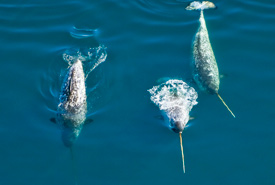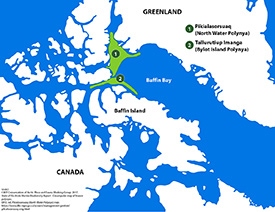What is a polynya?

Narwhals (Photo by Mario Cyr)
A polynya, pronounced “pol-en-ya,” is a large, naturally occurring area of open water surrounded on all sides by sea ice. But its function and how it is formed are much more complex than its appearance suggests. In Canada’s Arctic, there are 23 locations where these areas of open water occur.
How are polynyas formed?
Polynyas are formed in two ways, both of which involve heat. A sensible heat polynya is created when warmer water rises to the surface of the ocean, keeping the temperature of the surface water at or above zero degrees and preventing ice from forming. The other way a polynya is formed is when wind or ocean currents move a portion of sea ice away from a fixed point, such as a coastline. This polynya, called a latent heat polynya, is considered the area between the broken off portion and the fixed point. Polynyas vary in size, and the size of each polynya varies over the seasons.
How does a hole in a chunk of ice help marine life?
Many Arctic species are adapted to sea ice environments, but as ice forms across much of the Arctic Ocean in the winter, species that rely on open water to survive become concentrated at and dependent on polynyas. The open water within the polynyas is one of the most productive ecosystems in the Arctic, as their warmer water temperatures house plankton for Arctic cod to consume. With a bounty of fresh cod within a flipper’s reach, narwhal, whales and walruses are able to feed on the fish. Polar bears often hunt for seals along the ice edge of polynyas. The richness of these polynyas supports the entire Arctic ecosystem; loss of polynyas would have negative consequences across the Arctic.
The North Water Polynya, Pikialasorsuaq in Inuit, meaning “The Great Upwelling,” is located between Canada and Greenland. It is the largest Arctic polynya and provides refuge to marine mammals to feed and rest. But marine mammals aren’t the only species getting their fill. The North Water Polynya is a haven for millions of seabirds. Globally significant populations of thick-billed murres breed at coastal colonies located adjacent to the North Water Polynya and rely on it as a source of open water for feeding during the early breeding season.
Polynyas are also culturally significant to many Inuit in what is now Canada and Greenland for subsistence hunting and as meeting places during the harsh winter season.
What threatens polynyas?
Polynyas are most threatened by climate change, which is causing reductions in sea ice and shifting ocean currents. They are also threatened by increased shipping traffic and ice-breaking activities that disturb the natural formation of sea ice.
How is NCC protecting this habitat?
Conservation of polynyas is critical in supporting the wildlife and humans that depend on them. Tallurutiup Imanga is an area north of Baffin Island that contains a latent heat polynya, making it one of the Arctic’s most biologically productive marine areas. The area is home to species such as polar bears, seals, narwhals, belugas and bowhead whales. It also serves as a migratory route for marine mammals, such as bowhead whales, narwhals and sea birds species, such as black-legged kittiwake.
Inuit communities, along with other conservation organizations, have been working for decades to advance this globally significant marine conservation area.
In 2016, the Nature Conservancy of Canada (NCC) helped accelerate this globally significant marine conservation area by accepting the voluntary release by Shell Canada of 30 offshore exploratory oil and gas permits, representing more than 860,000 hectares at the eastern entrance to the Northwest Passage and Tallurutiup Imanga. NCC subsequently released those permits to the Government of Canada. This facilitated the expansion of the marine conservation area to the larger boundary proposed by the Qiqiktani Inuit Association.





